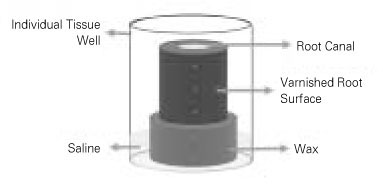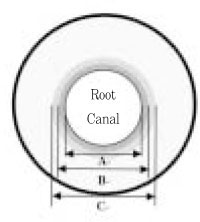Evaluation of time-dependent antimicrobial effect of sodium dichloroisocyanurate (NaDCC) on Enterococcus faecalis in the root canal
- Affiliations
-
- 1Department of Conservative Dentistry, College of Dentistry, Kangnung National University, Korea. mendo7@kangnung.ac.kr
- KMID: 2175845
- DOI: http://doi.org/10.5395/JKACD.2007.32.2.121
Abstract
- The purpose of this study was to assess the antibacterial effect of sodium dichloroisocyanurate (NaDCC), sodium hypochlorite (NaOCl), and chlorhexidine (CHX) on Enterococcus faecalis and to evaluate and to compare the time-dependant antimicrobial effect of NaDCC with NaOCl and CHX in the root canal in vitro before and after instrumentation. Extracted human single teeth were prepared by serial instrumentation technique. The samples were autoclaved and contaminated for 3 days with E. faecalis monocultures. The teeth were then divided into 4 groups. Each group was irrigated and inserted with 2% NaOCl, 2% NaDCC, 2% CHX and sterilized saline. After 6, 12, 24, 72h, and 1 week incubation, sterilized paper point was inserted into the root canal. Paper points containing root canal contents were then placed on the agar plate. And then each root canal was prepared with #4 and #5 GG (Gates-Glidden) drill. The debris were collected in the sterilized microtube and the plates were incubated at 37degrees C in an increased CO2 atmosphere. After 24h incubation the growth of bacteria around the paper points were measured. NaOCl and NaDCC solution shows similar antimicrobial effect for E. faecalis at 6, 12, 24, 72h and 1 week. In control group, irrigated with sterilized saline, no antimicrobial effect was observed. The results are in agreement with other investigators, who have shown the bactericidal property and possibility of NaDCC as a root canal irrigation solution. Thus it seems that NaDCC solutions can be clinically applied into the root canal within 1 week after dilution.
Keyword
MeSH Terms
Figure
Cited by 5 articles
-
The effect of MTAD as a final root canal irrigants on the coronal bacterial leakage of obturated root canals
Tae Woo Kim, Seok Woo Chang, Dong Sung Park
J Korean Acad Conserv Dent. 2008;33(4):397-404. doi: 10.5395/JKACD.2008.33.4.397.Comparison of Antibacterial effect of Listerine® with Various root canal irrigants
Young Hun Kim, Min-Kyung Kang, Eun-Kyoung Choi, So-Young Yang, Inseok Yang, In-Chol Kang, Yun-Chan Hwang, In-Nam Hwang, Won-Mann Oh
J Korean Acad Conserv Dent. 2009;34(6):500-507. doi: 10.5395/JKACD.2009.34.6.500.Analysis of para-chloroaniline after chemical interaction between alexidine and sodium hypochlorite using mass spectrometry: A preliminary study
Hyeon-Sik Kim, Seung-Hyun Han, Soram Oh, Sang-Min Lim, Yu Gu, Kee-Yeon Kum
J Korean Acad Conserv Dent. 2010;35(4):295-301. doi: 10.5395/JKACD.2010.35.4.295.The comparison of different canal irrigation methods to prevent reaction precipitate between sodium hypochlorite and chlorhexidine
Moon-Sun Choi, Se-Hee Park, Kyung-Mo Cho, Jin-Woo Kim
J Korean Acad Conserv Dent. 2010;35(2):80-87. doi: 10.5395/JKACD.2010.35.2.080.Microorganism penetration in dentinal tubules of instrumented and retreated root canal walls. In vitro SEM study
Saad Al-Nazhan, Alaa Al-Sulaiman, Fellwa Al-Rasheed, Fatimah Alnajjar, Bander Al-Abdulwahab, Abdulhakeem Al-Badah
Restor Dent Endod. 2014;39(4):258-264. doi: 10.5395/rde.2014.39.4.258.
Reference
-
1. Kakehashi S, Stanley HR, Fizgerald RJ. The effects of surgical exposures of dental pulps in germ-free and conventional laboratory rats. Oral Surg Oral Med Oral Pathol. 1965. 20:340–349.
Article2. Byström A, Sundqvist G. Bacteriologic evaluation of the efficacy of mechanical root canal instrumentation in endodontic therapy. Scand J Dent Res. 1981. 89:321–328.
Article3. Haapasalo M, Endal U, Zandi H, Jeffrey M. Eradication of endodontic infection by instrumentation and irrigation solutions. Endod Topics. 2005. 10:77–102.
Article4. Sundqvist G, Fiigdor D, Persson S, Sjögren U. Microbiologic analysis of teeth with failed endodontic treatment and the outcome of conservative re-treatment. Oral Surg Oral Med Oral Pathol Oral Radiol Endod. 1998. 85:86–93.
Article5. Heling I, Chandler NP. Antimicrobial effect of irrigant combinations within dentinal tubules. Int Endod J. 1998. 31:8–14.
Article6. Barrette WC Jr, Hannum DM, Wheeler WD, Hurst JK. General mechanism for the bacterial toxicity of hypochlorous acid: abolition of ATP production. Biochemistry. 1989. 28:9172–9178.
Article7. McKenna SM, Davies KJ. The inhibition of bacterial growth by hypochlorous acid. Possible role in the bactericidal activity of phagocytes. Biochem J. 1988. 254:685–692.
Article8. Siqueira JF Jr, Machado AG, Silveira RM, Lopes HP, de Uzeda M. Evaluation of the effectiveness of sodium hypochlorite used with three irrigation methods in the elimination of Enterococcus faecalis from the root canal, in vitro. Int Endod J. 1997. 30:279–282.
Article9. McComb D, Smith DC, Beagrie GS. The results of in vivo endodontic chemomechanical instrumentation--a scanning electron microscopic study. J Br Endod Soc. 1976. 9:11–18.
Article10. Coates D. Comparison of sodium hypochlorite and sodium dichloroisocyanurate disinfectants: neutralization by serum. J Hosp Infect. 1988. 11:60–67.
Article11. Coates D. A comparison of sodium hypochlorite and sodium dichloroisocyanurate products. J Hosp Infect. 1985. 6:31–40.
Article12. Russell AD, Day MJ. Antibacterial activity of chlorhexidine. J Hosp Infect. 1993. 25:229–238.
Article13. White RR, Hays GL, Janer LR. Residual antimicrobial activity after canal irrigation with chlorhexidine. J Endod. 1997. 23:229–231.
Article14. Russell AD. Activity of biocides against mycobacteria. Soc Appl Bacteriol Symp Ser. 1996. 25:87S–101S.
Article15. Goldman M, Pearson AH. Postdebridement bacterial flora and antibiotic sensitivity. Oral Surg Oral Med Oral Pathol. 1969. 28:897–905.16. Basrani B, Tjaderhane L, Santos JM, Pascon E, Grad H, Lawrence HP, Friedman S. Efficacy of chlorhexidine- and calcium hydroxide-containing medicaments against Enterococcus faecalis in vitro. Oral Surg Oral Med Oral Pathol Oral Radiol Endod. 2003. 96:618–624.
Article17. Haapasalo M, Østavik D. In vitro Infection and Disinfection of Dentinal Tubules. J Dent Res. 1987. 66:1375–1379.18. Eddy RS, Joyce AP, Roberts S, Buxton TB, Liewehr F. An in vitro evaluation of the antibacterial efficacy of chlorine dioxide on E. faecalis in bovine incisors. J Endod. 2005. 31:672–675.
Article19. Kuruvilla JR, Kamath MP. Antimicrobial activity of 2.5% sodium hypochlorite and 0.2% chlorhexidine gluconate separately and combined, as endodontic irrigants. J Endod. 1998. 24:472–476.
Article20. Ringel AM, Patterson SS, Newton CW, Miller CH, Mulhern JM. In vivo evaluation of chlorhexidine gluconate solution and sodium hypochlorite solution as root canal irrigants. J Endod. 1982. 8:200–204.
Article21. Harrison JW, Hand RE. The effect of dilution and organic matter on the anti-bacterial property of 5.25% sodium hypochlorite. J Endod. 1981. 7:128–132.
Article22. Vahdaty A, Pitt Ford TR, Wilson RF. Efficacy of chlorhexidine in disinfecting dentinal tubules in vitro. Endod Dent Traumatol. 1993. 9:243–248.23. Dametto FR, Ferraz CC, De Almeida Gomes BP, Zaia AA, Teixeira FB, De Souza-Filho FJ. In vitro assessment of the immediate and prolonged antimicrobial action of chlorhexidine gel as an endodontic irrigant against Enterococcus faecalis. Oral Surg Oral Med Oral Pathol Oral Radiol Endod. 2005. 99:768–772.
Article24. Lee WC, Kang BS, Kim CH, Son HH. Evaluation of sodium dichloroisocyanurate as a root canal irrigation solution; Cl- concentration, pH, cytotoxicity and antimicrobial effect in vitro. J Korean Acad Conserv Dent. 2003. 28:425–430.
Article
- Full Text Links
- Actions
-
Cited
- CITED
-
- Close
- Share
- Similar articles
-
- Evaluation of Sodium Dichloroisocyanurate as a root canal irrigation solution; Cl- concentration, pH, Cytotoxicity and Antimicrobial effect in vitro
- Antimicrobial effect of calcium hydroxide as an intracanal medicament in root canal treatment: a literature review - Part I. In vitro studies
- The effect of MTAD as a final root canal irrigants on the coronal bacterial leakage of obturated root canals
- Reconsideration of treatment protocol on the reduction of Enterococcus faecalis associated with failed root canal treatment
- Antibacterial effect of urushiol on E. faecalis as a root canal irrigant




